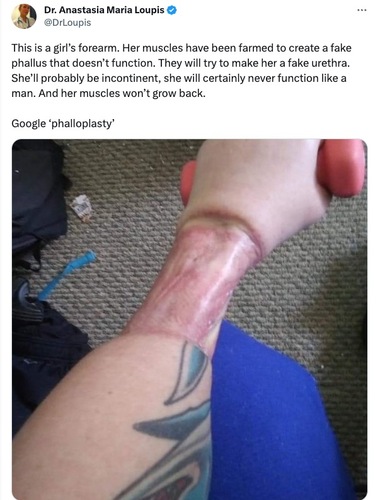
(function(d, s, id) { var js, fjs = d.getElementsByTagName(s)[0]; if (d.getElementById(id)) return; js = d.createElement(s); js.id = id; js.src = “https://connect.facebook.net/en_US/sdk.js#xfbml=1&version=v3.0”; fjs.parentNode.insertBefore(js, fjs); }(document, ‘script’, ‘facebook-jssdk’)); –>
–>
July 25, 2023
There is much talk about gender-affirming surgery (“GAS”). A lot of it surrounds the initiatives taken by some hospitals and medical centers to make these surgeries available to teenagers and, reportedly, younger children. What we seldom talk about is what exactly is going on with these surgeries. It’s worth working our way down through the products being sold to the reality behind the sales pitches.
‘); googletag.cmd.push(function () { googletag.display(‘div-gpt-ad-1609268089992-0’); }); document.write(”); googletag.cmd.push(function() { googletag.pubads().addEventListener(‘slotRenderEnded’, function(event) { if (event.slot.getSlotElementId() == “div-hre-Americanthinker—New-3028”) { googletag.display(“div-hre-Americanthinker—New-3028”); } }); }); }
The American Society of Plastic Surgeons has a list of “Gender Affirmation Surgeries,” which they explain have as their goal “to give transgender individuals the physical appearance and functional abilities of the gender they know themselves to be.” The surgeries that a “multispecialty team that typically includes board-certified plastic surgeons” perform are intended to make men look more like women, women look more like men, and both to look more like neither. To this end, they re-sculpt facial bones, give men boob jobs, castrate men and create fake “vaginas,” give women mastectomies, and cut skin off of women’s bodies to create fake penises. All of it, of course, is dressed up in euphemisms:
The goal of transmasculine top surgery, or masculinizing chest surgery, is to remove the breast tissue from both breasts and create a masculine or nonbinary appearance to the chest.
[snip]
‘); googletag.cmd.push(function () { googletag.display(‘div-gpt-ad-1609270365559-0’); }); document.write(”); googletag.cmd.push(function() { googletag.pubads().addEventListener(‘slotRenderEnded’, function(event) { if (event.slot.getSlotElementId() == “div-hre-Americanthinker—New-3035”) { googletag.display(“div-hre-Americanthinker—New-3035”); } }); }); }
The goal of transmasculine bottom surgery, or masculinizing genital surgery, is to reconstruct the female genitalia into male genitalia.
Plastic surgery has developed over time to have two aspects: Reconstructive surgery for body parts damaged by injury or disease and cosmetic surgery to augment people’s looks according to their preferences.

Image: Gender affirming care? (A woman’s arm after surgeons give her a fake “penis.”) Twitter screen grab.
Under those definitions, it’s apparent that so-called “gender affirming surgery” is cosmetic surgery (with an occasional bit of the internal if organs are also taken (e.g., hysterectomy, ovariectomy)). It is voluntary, elective, and performed on normal parts of the body. Cosmetic surgery’s only purpose is to improve appearance or remove signs of aging. A collateral benefit may be that the person feels more comfortable in his or her own skin, or what’s left of it, because the person now looks as he or she wishes to appear.
More specifically, what is the point of gender-affirming surgery, i.e., what does it affirm exactly?
Affirm is etymologically from “Middle English affermen, affirmen, “to decide upon” (c. 1300); “to state positively” (late 14c.)…”
Decide “late 14c., “to settle a dispute, determine a controversy,” from Old French decider, from Latin decidere “to decide, determine,”
‘); googletag.cmd.push(function () { googletag.display(‘div-gpt-ad-1609268078422-0’); }); document.write(”); googletag.cmd.push(function() { googletag.pubads().addEventListener(‘slotRenderEnded’, function(event) { if (event.slot.getSlotElementId() == “div-hre-Americanthinker—New-3027”) { googletag.display(“div-hre-Americanthinker—New-3027”); } }); }); } if (publir_show_ads) { document.write(“
The etymology of affirmation is “early 15c., “assertion that something is true,” from Old French afermacion “confirmation” (14c.), from Latin affirmationem (nominative affirmatio) “an affirmation, solid assurance,”…”
So when you “affirm” something, you have “decided” it, you have “settled the matter,” and you have “confirmed” it.
But…
According to Democrats and other leftists, gender is fluid.
What does gender fluid mean? From WebMD:
Someone who is fluid — also called gender fluid — is a person whose gender identity (the gender they identify with most) is not fixed. It can change over time or from day-to-day. Fluid is a form of gender identity or gender expression, rather than a sexual orientation.
Fluid relates to how a person identifies themselves internally and presents themselves to the world. A person who is gender fluid may identify as male one day, female the next, both male and female, or neither. It affects their gender expression — the way a person presents themself to society (masculine, feminine, both, or neither).
Gender, apparently, is like the weather: It changes and has no stationary target.
For me, this raises some issues. If I choose to have a plastic procedure, such as a nose job, have I received affirmation that I had a large/small/abnormal nose? Does breast augmentation or reduction surgery affirm that my boobs were too small or too big, respectively? Can one affirm what is transient or changeable?
As a bottom line, does gender-affirming surgery solidify the fluidity and decide/settle the gender identity matter?
It does not, and it cannot, as gender remains fluid. Examples are found in the post-gender-affirming surgery persons who have patient’s remorse.
There are problems with inexactitude. There are problems with poor descriptors. The lack of precise language, especially when it comes to what is believed to be health care, can matter. To suggest that gender-affirming surgery affirms anything is to commit advocacy.
GAS may alleviate the discomforts of some. It may provide temporary or long-lasting peace to some. But it cannot promise to affirm.
Consider the names of other surgeries:
Bowel resection—this lives up to its promise. You can bet your life (which you do) that when you survive the surgery, your bowel will have been resected.
Cholecystectomy—after this one, your gall bladder is gone.
Lung resection—wake-up with less lung since some has been removed.
And so on.
In virtually no other surgical intervention is the language touchy-feely, warm, and fuzzy. This is not medical nomenclature. It is advertising. False, at that.
A better descriptive name (or names) should be applied that more honestly describes these procedures. They/it need not be as accurate as “Give a chick a dick surgery” or “Give a hunk a c**t surgery.” Something in between GAS and these may suffice.
The idea is not to suggest an outcome that cannot be promised and to let the patient know what is really going on.
That is honest.
And anything else, i.e., a non-neutral description, interferes with informed consent by prejudicing the patient’s understanding. This may have consequences. A truly informed consent is necessary to avoid a malpractice suit.
Caveat doctor. Patients—you may have recourse.
<!–
–>
<!– if(page_width_onload <= 479) { document.write("
“); googletag.cmd.push(function() { googletag.display(‘div-gpt-ad-1345489840937-4’); }); } –> If you experience technical problems, please write to [email protected]
FOLLOW US ON
<!–
–>
<!– _qoptions={ qacct:”p-9bKF-NgTuSFM6″ }; ![]() –> <!—-> <!– var addthis_share = { email_template: “new_template” } –>
–> <!—-> <!– var addthis_share = { email_template: “new_template” } –>






